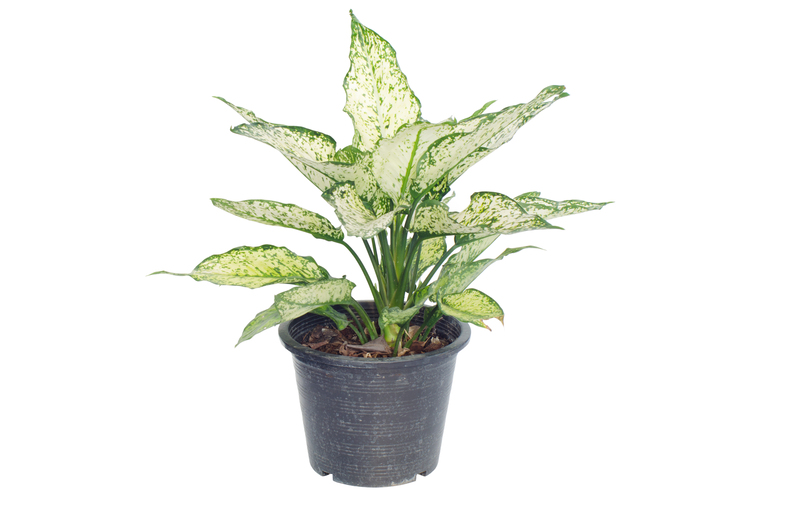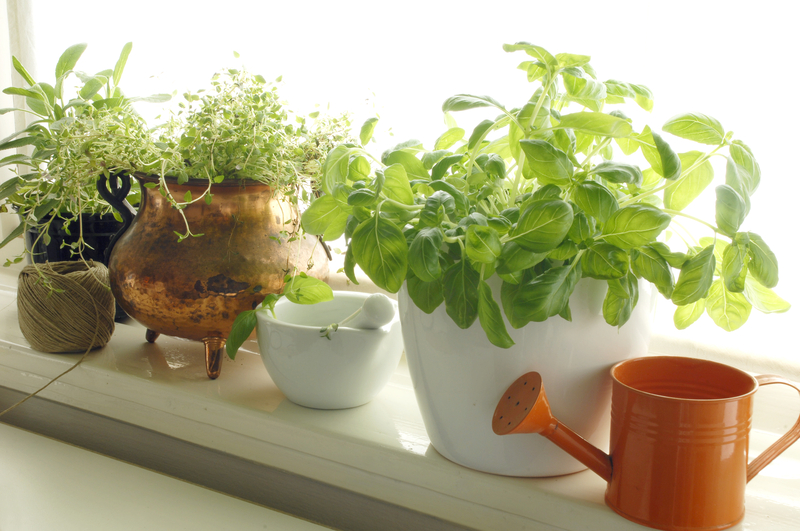Innovative Vertical Gardening for Limited Spaces
Posted on 04/06/2025
Innovative Vertical Gardening for Limited Spaces: Maximizing Greenery
In our rapidly urbanizing world, innovative vertical gardening for limited spaces is transforming how we approach greenery at home or in the office. With living spaces shrinking and outdoor areas becoming scarce, vertical gardens are an elegant, efficient, and eco-friendly solution to bring nature indoors and make the most of every square foot. In this comprehensive guide, we'll explore creative ideas, practical methods, and expert tips to help you master vertical gardening in small spaces, whether you live in an apartment, a condo, or a house with a tiny yard.
What is Vertical Gardening?
Vertical gardening involves growing plants upwards on structures rather than horizontally across traditional ground plots. Employing a wide variety of systems -- from wall-mounted pockets to freestanding trellises and hydroponic panels -- vertical gardens can turn bland walls, fences, balconies, or even interior partitions into lush, living landscapes. This approach is particularly well-suited for gardening in tight spaces where growing out isn't an option but growing up makes it possible to create vibrant, functional green areas.
Why Choose Vertical Gardening for Small Spaces?
- Space Efficiency: Maximize limited floor area by utilizing walls, railings, and other vertical surfaces.
- Enhanced Aesthetics: Add lush visual appeal to otherwise plain or unused corners.
- Improved Air Quality: Plants help filter indoor and urban air, making environments healthier.
- Increased Privacy: Vertical gardens can act as natural dividers or privacy screens for balconies and patios.
- Versatility & Flexibility: Adaptable designs mean you can grow flowers, herbs, vegetables, or ornamental plants, even indoors.
Types of Innovative Vertical Gardening Solutions
There is a wide range of vertical gardening systems available. Here are popular and effective methods designed for innovation and optimal use of limited spaces:
- Living Walls / Green Walls: Pre-made panels or custom frameworks that support a variety of plants, suitable for both indoor and outdoor use.
- Vertical Planter Towers: Stackable pots or columns that allow upward-growing gardens on patios, decks, or even kitchen counters.
- Pocket Planters: Felt or fabric pouches that attach to walls and can house herbs, flowers, or even leafy greens.
- Pallet Gardens: Repurposed wooden pallets fitted with soil and plants, ideal for DIY enthusiasts seeking affordable solutions.
- Hanging Gardens: Suspended planters, baskets, or containers attached to ceilings or railings.
- Trellises and Grids: Traditional or modern structures supporting climbing plants like beans, peas, or vining flowers.
- Hydroponic Vertical Gardens: Soilless systems where plants receive nutrients through water, excellent for small interiors or balconies.
Benefits of Vertical Gardens in Limited Spaces
Choosing vertical gardening for small areas comes packed with unique advantages:
- Urban Agriculture: Grow your own food even in inner cities.
- Climate Control: Green walls help regulate indoor temperatures and reduce energy costs.
- Biodiversity Boost: Vertical gardens provide habitat for pollinators and beneficial insects.
- Noise Reduction: Foliage can absorb and dampen urban noise, creating a serene living environment.
- Mental Wellness: Bringing nature closer has been linked to improved mood, focus, and creativity.
How to Start a Vertical Garden in Small Spaces
Are you ready to create your own vertical garden at home? Follow these steps for a thriving green space:
Select the Right Location
- Consider sunlight exposure -- most vegetables and herbs need at least six hours per day.
- Check for ease of watering and maintenance access.
- Indoor or outdoor walls, fences, balconies, or sunny windows are all great candidates.
Choose Your Vertical Garden System
- Modular panels are perfect for covering large areas quickly.
- Pocket planters suit experimenters who like regularly changing their plant selection.
- Stacked or tower planters are best for patios and small balconies.
- DIY trellises work well for climbing plants and vines, indoors or outdoors.
Select Appropriate Plants
The best plants for vertical gardening in compact spaces are those that don't require deep roots or extensive horizontal sprawl. Popular choices include:
- Herbs: Basil, mint, parsley, oregano, thyme, and chives.
- Greens: Lettuces, spinach, kale, arugula, and Swiss chard.
- Strawberries: Perfect for planters or pockets, offering sweet rewards.
- Cherry tomatoes & peppers: Smaller varieties thrive in vertical setups.
- Succulents: Low-maintenance, require little space, ideal for decorative panels.
- Ornamental flowers: Petunias, pansies, and nasturtiums add color and vibrancy.
- Climbing vines: Peas, beans, and flowering vines for trellis-based systems.
Soil, Watering, and Fertilizing Techniques
Proper care is crucial for the success of your vertical green wall or planter:
- Soil: Use light, well-draining potting mix enriched with compost. Specialized vertical garden soils can help retain moisture while preventing excess weight.
- Watering: Vertical systems tend to dry out faster than ground gardens. Consistent watering is key; consider drip irrigation for larger installations.
- Fertilizing: Use slow-release organic fertilizers or diluted liquid feeds to nurture healthy, vibrant plants.
Creative and Decorative Ideas for Innovative Vertical Gardening
Bring style and innovation to your vertical garden for small apartments or offices with these inspiring ideas:
- Frame It: Use a picture-frame planter for a living art piece.
- Pallet Wall: Upcycle pallets into rustic, modular herb gardens.
- Mason Jar Magic: Attach jars to wooden boards or railings for a chic, glassy look.
- Repurposed Shoe Organizers: Plastic or fabric over-the-door shoe organizers can serve as pocket planters for herbs and greens.
- Recycled Bottles: Cut plastic bottles can become unique, eco-friendly planters hung on vertical grids.
- Geometric Shelves: Combine hexagonal or triangular shelves filled with succulents to create a modern, architectural wall garden.
- Colorful Containers: Mix and match planter colors for visual interest and theme coordination.
Maintenance Tips for Prolonged Success
- Prune and Rotate: Regularly trim dead leaves and rotate plants for balanced growth.
- Monitor Pests: Keep an eye out for insects and address issues promptly with organic methods.
- Refresh Soil: Swap out or amend soil in pockets and planters annually.
- Manage Light: Ensure adequate lighting, especially for indoor setups; consider grow lights to supplement natural light.

Frequently Asked Questions About Vertical Gardening in Tight Spaces
Can vertical gardens truly work indoors?
Yes! Many vertical garden systems are designed specifically for the indoors. With adequate light (natural or artificial) and attentive watering, a lush indoor vertical garden is entirely achievable, even in the most cramped apartments.
How much maintenance does a vertical garden require?
Maintenance depends on your setup and plant choice. Edible and flowering plants generally need more care than succulents. Automated watering systems, self-watering planters, and proper plant selection can significantly reduce daily effort.
Will vertical gardening damage walls or surfaces?
When properly installed, most vertical systems do not damage walls. Ensure panels include a vapor barrier or backing, and use appropriate mounting hardware for stability and safety.
Are hydroponic vertical gardens suitable for beginners?
Hydroponic systems can be very rewarding and efficient but may require monitoring and setup. Many pre-made kits are designed for novices and come with easy instructions, making modern vertical hydroponics a feasible option for limited spaces.

Top 10 Tips for a Thriving Vertical Garden in Small Spaces
- Assess Light & Space: Plan your garden based on real sunlight availability and wall or railing position.
- Start Small: Begin with a few easy-care plants before scaling up.
- Choose Hardy Plants: Opt for species that thrive in your given conditions and require minimal attention.
- Invest in Quality Structures: Durable mounting hardware and sturdy containers prevent accidents and plant loss.
- Ensure Proper Drainage: Avoid root rot by using containers that drain and don't let water accumulate against surfaces.
- Use Lightweight Mix: Lighter soils reduce strain on walls and mounting points.
- Supplement Lighting: For interiors, use full-spectrum grow lights to boost photosynthesis.
- Rotate Plants: Changing plant positions ensures even light distribution and growth.
- Regular Feeding: Monthly or biweekly feeding keeps plants healthy and productive.
- Keep Innovating: Experiment with new designs, plants, and arrangements to keep your vertical garden fresh and engaging.
Conclusion: Going Upward for Urban Gardening Success
With a bit of creativity and resourcefulness, innovative vertical gardening for limited spaces empowers anyone--no matter how compact their environment--to create a flourishing, restorative oasis. Whether you're longing for fresh herbs at your fingertips, a splash of greenery in your living room, or a dynamic green wall on your balcony, vertical gardening is the ultimate solution for modern urban living.
Remember: Every wall or free vertical surface is an opportunity to grow. Start simple, stay consistent, and enjoy the satisfaction of growing upward!
Need More Inspiration?
Explore local garden centers or online resources for the latest vertical gardening trends, innovative DIY kits, and community groups where you can share successes and tips. There's no limit to how you can redefine your space with vertical gardening innovation!



